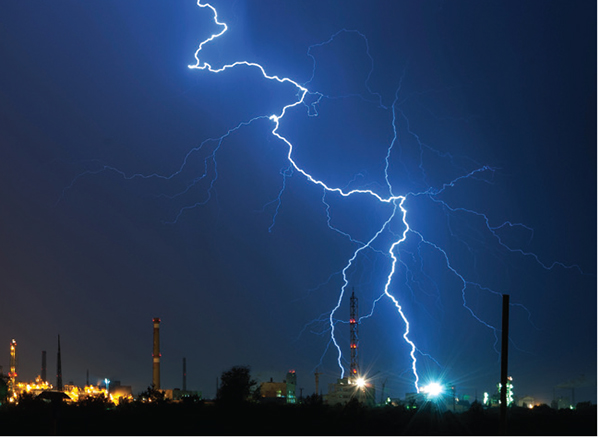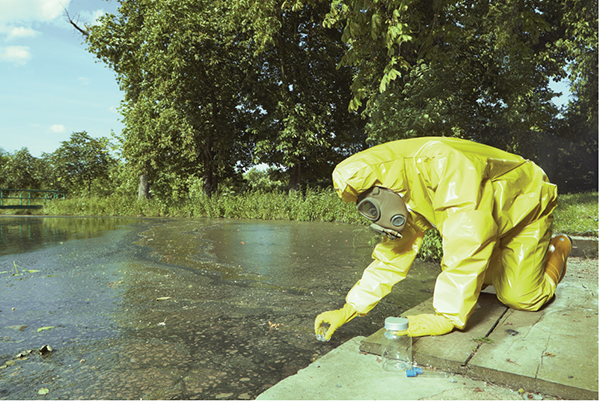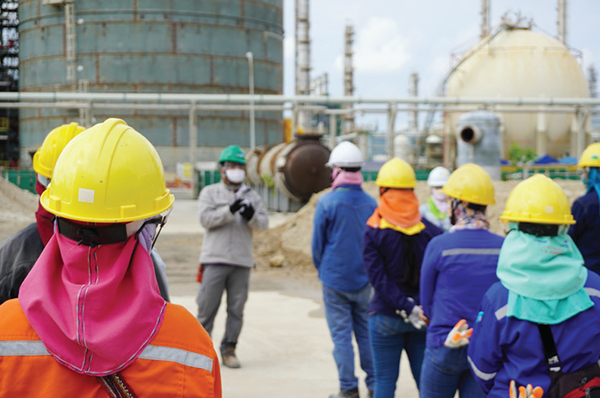Detailed plans for handling hazardous materials should be a central part of any chemical plant’s disaster preparedness plan
Over the past year, many chemical facilities managed to overcome extreme circumstances. One instance of an extreme event was the winter storm in Texas in February 2021, where unexpected weather conditions resulted in widespread power outages and mass water supply shortages.
Due to power-grid failures, it is estimated that the storm caused blackouts for over 5.2 million homes and businesses, becoming one of the largest blackout events in modern American history [1]. This highlighted the need to be prepared for all aspects of how energy impacts a business’ operations. A lack of a primary energy source, as well as a water supply, could impact a facility’s ability to function safely.
Though many consider disasters to encompass only “natural” geologic and meteorological processes — storms, floods, hurricanes, tornadoes, volcanic eruptions, earthquakes, tsunamis and others — future pandemics and similar events should also be considered in preparedness plans (Figure 1).

FIGURE 1. A chemical plant’s emergency-response plan should consider not only natural disasters, such as major storms or earthquakes, but also unprecedented events, such as future pandemics
For example, at the onset of the COVID-19 pandemic, the Occupational Safety and Health Administration (OSHA; Washington, D.C., www.osha.gov) set safety standards to ensure that employers were better prepared and acting on the impacts of their employees’ exposure to hazardous waste and other health risks as a result of the virus [2]. Most facilities were caught off guard by the virus and did not have personal protective equipment (PPE), such as masks and gloves, and adequate sanitizing products on hand.
Unfortunately, the frequency and intensity of extreme events like Winter Storm Uri in Texas and the pandemic seems to be trending upward. According to a March 2021 report from the United Nations Food and Agriculture Organization (FAO), natural disasters are occurring three times more often than 50 years ago [3]. Considering the magnitude of the destruction caused by disasters, professionals in the chemical process industries (CPI)should help their facilities prepare well in advance for these costly and potentially catastrophic events.
Any type of unprecedented event can put chemical plants at tremendous risk in terms of asset damage, environmental mishaps related to the loss of hazardous materials, and risk to personnel and the community — all of which can be both costly and deadly. These risks can be reduced by proper planning and disaster preparedness. Simply put — it is vital for facilities to reassess operations and worst-case scenario assumptions.
Disasters can create significant health and safety risks for the individuals who work within CPI facilities, often in the form of hazardous waste spills and leaks. Potential environmental risks also include air, water, ground or soil contamination due to runoff (Figure 2).

FIGURE 2. The disaster risks that chemical plants must consider include potential loss of containment of highly hazardous materials, leading to contamination of water, air or soil
To reduce the risks of injury, environmental harm or regulatory penalties, a successful disaster response requires extensive expertise and knowledge of hazardous materials and waste management, including applicable procedures and regulations.
This article discusses some hazardous wastes that are common in CPI facilities. It outlines several considerations that chemical engineers, environmental engineers and environmental, health and safety (EHS) professionals should keep in mind when handling waste streams before, during and after flooding, high winds and other extreme weather conditions or unexpected events.
Defining hazardous-waste types
The U.S. Environmental Protection Agency (EPA; Washington, D.C.; www.epa.gov) defines hazardous waste as “waste with properties that make it dangerous or capable of having a harmful effect on human health or the environment.” It is generated from many sources, ranging from industrial manufacturing process wastes to batteries and may come in many forms, including liquids, solids, gases and sludges, [4]. To learn more about hazardous waste regulations, please read Practicing Year-Round Waste Compliance, Chem. Eng., Jan. 2021, pp. 42–44 [5].
The EPA regulates hazardous waste under the Resource Conservation and Recovery Act (RCRA), which was enacted in 1976 to ensure that these wastes are managed in a safe and compliant manner [6]. The growing amount of waste generated has made it increasingly important for waste-management personnel to develop strategies to manage it safely. RCRA established a framework for the proper management of hazardous wastes, and from this authority, EPA has established a comprehensive regulatory program to ensure that hazardous waste is managed safely from “cradle to grave” — a mindset that encompasses the management of waste from the time it is created, through transportation, treatment and storage, until it is ultimately disposed of.
All waste generators must follow the framework established by RCRA. A hazardous waste generator is defined as any organization that produces a hazardous waste. Generators are regulated based on the amount of hazardous waste they create in a calendar month, not the size of their business or facility.
The EPA recognizes three categories of generators [7]:
1. Very Small Quantity Generators (VSQGs) generate 100 kg or less per month of hazardous waste or 1 kg or less per month of acutely hazardous waste.
2. Small Quantity Generators (SQGs) generate more than 100 kg but less than 1,000 kg of hazardous waste per month.
3. Large Quantity Generators (LQGs) generate 1,000 kg per month or more of hazardous waste, or more than 1 kg per month of acutely hazardous waste.
Many substances that are handled, stored and manufactured within chemical plants are regulated as hazardous waste. Therefore, engineers and other personnel must follow all requirements outlined within RCRA, as well as any other relevant federal, state or local regulations that dictate how to properly manage and dispose of hazardous waste.
Common hazardous wastes
Listed wastes are wastes that come from common manufacturing and industrial processes. They can also come from specific industries or can be discarded commercial products. A waste is determined to be a hazardous waste if it is specifically included on one of four lists — F, K, P or U — that are found in Part 261 of Title 40 of the Code of Federal Regulations (CFR) [8].
F-List. The F-List identifies wastes from common manufacturing and industrial processes as hazardous. Because the processes generating these wastes can occur in different sectors of the industry, F-List wastes are known as wastes from nonspecific sources. These wastes are divided into seven groups that depend on the type of manufacturing or industrial operation that creates them:
1. Spent solvent wastes
2. Electroplating and other metal-finishing wastes
3. Dioxin-based wastes
4. Waste from chlorinated aliphatic hydrocarbons production
5. Waste from wood-preserving activities
6. Sludge from petroleum refinery wastewater treatment
7. Multisource leachate
K-List.The K-List identifies hazardous wastes from specific sectors of the industry and manufacturing that are considered to be source-specific wastes. To qualify as a K-listed hazardous waste, an item must fit into one of the 13 categories on the list, and the waste must match one of the detailed K-List waste descriptions in the dedicated CFR section. The processes that generate K-List wastes are as follows:
1. Wood preservation
2. Organic chemicals manufacturing
3. Pesticides manufacturing
4. Petroleum refining
5. Veterinary pharmaceuticals manufacturing
6. Inorganic pigment manufacturing
7. Inorganic chemicals manufacturing
8. Explosives manufacturing
9. Iron and steel production
10. Primary aluminum production
11. Secondary lead processing
12. Ink formulation
13. Coking
P-and U-Lists.The P-and U-Lists designate hazardous waste as pure, commercial-grade formulations of certain unused chemicals that are being disposed of. For a waste to be considered a P- or U-List, it must meet the following criteria: the waste must contain one of the chemicals listed on the P- or U-List; the chemical in the waste must be unused; and the chemical in the waste must be in the form of a commercial chemical product.
The P-List identifies acute hazardous wastes from discarded commercial chemical products. The U-List identifies hazardous wastes from discarded commercial chemical products. Both the P- and U-listed chemicals refer to materials or products that can no longer be used for their intended purpose. However, the P-listed chemicals are referred to as acutely hazardous waste because they are very hazardous even in small amounts, such as cyanides.
Other hazardous wastes. Other hazardous wastes are known as characteristic wastes. These are wastes that exhibit any one or more of the following characteristic properties: ignitability, corrosivity, reactivity or toxicity.
Engineers at CPI facilities should consult the EPA’s website for an inventory of listed and characteristic wastes. State regulatory requirements for waste generators may be more stringent than those of the federal RCRA program, so as previously said, it is crucial to check state-specific policies as well [9].
Emergency contingency plans
Once hazardous wastes are classified, the next step is to not only keep up with day-to-day operations, proper waste segregation and year-round compliance — but also to account for extreme circumstances.
Being prepared for potential disasters can help CPI firms to mitigate some potential damage and safeguard employees, communities and the environment. Outlined here and in the following sections are several steps to take to protect facilities in the event of a disaster.
Every large CPI facility should have a contingency plan in place for extreme weather events, which includes an emergency response plan. Some third-party waste management providers may create this on a firm’s behalf as part of an existing or new service agreement.
To begin, it is recommended to assess a facility’s risk for incidents related to natural disasters. For example, a business on the Pacific coast has the greatest risk of being impacted by earthquakes, wildfires and mudslides, while a facility on the Atlantic coast may be more likely to encounter hurricanes and flooding.
A plan should be put in place before it is ever needed. That plan should consider several factors — first, engineers and plant executives should work together to determine emergency response roles. Decide who will make crucial decisions in the event of a storm and who will be involved in hazardous waste management and removal.
An ideal emergency response plan should include a proper, strategic communication protocol and chain of command. One of the biggest mistakes companies make when preparing for a natural disaster is a lack of communication. Communication that is not handled properly creates additional obstacles for organizations to overcome during and after the disaster.
Especially in the aftermath of COVID-19 and the lessons learned around the world, companies should revisit the concept of stockpiling supplies. It is important to have a certain amount of reserved supplies to manage operations through a power outage or other conditions to make sure employees can protect themselves. What can be identified now that was needed before the pandemic or the last natural disaster? This can include personal protective equipment (PPE), such as masks or gloves, sanitizing wipes, bleach, toilet paper, power generators, water reserves and more (Figure 3).

FIGURE 3. A chemical plant’s disaster preparedness plan should ensure that the plant has an ample stock of necessary PPE for workers, as well as other essential items
Teams should also determine how to secure all hazardous chemicals safely outside of potential flooding areas. Identify what hazardous wastes could be generated as a result of loss of containment or loss of power. Also consider what type of reporting will need to be completed after the incident.
Finally, once a plan is in place, engineers and their teams should go through exercises to work the muscles of the program. With the frequency and severity of these events increasing, it is not good enough to have a plan sitting on a shelf — teams need to go through real-life drills to understand the impact of communication and operation breakdowns. What will be done if there is not access to the items that were counted on? What if someone in the communication chain is not present during the event? What tasks are missing support that someone needs to be assigned to manage? Address these potential scenarios in the plan.
Choosing a partner
To remain compliant in the industry’s ever-changing regulatory environment, it is highly recommended to work with a third-party partner that is knowledgeable in waste management. Working closely with a dedicated and experienced partner for both emergencies and day-to-day operation ensures continuity and consistent communication.
In many cases, the correct response to a disaster might not be obvious to the untrained eye because, after a disaster, hazardous wastes may look the same as non-hazardous wastes. However, hazardous wastes cannot simply be put in a trash can and taken away. Hazardous wastes need to be identified, segregated and properly disposed of to ensure compliance.
Experienced waste management experts that specialize in emergency response and planning can partner with a plant’s leadership team to provide critical advisory services to help minimize risk. From the initial response to cleanup and ultimate closeout of all regulatory paperwork and reporting, this third-party partner can help to manage risk throughout the entire lifecycle.
When facing a large-scale event, emergency response organizations can assemble a nationwide network of experts, facilities, equipment and subcontractors. Managing hazardous wastes through an emergency-response specialist helps CPI plants to find proper disposal outlets and enlist expert help with onsite segregation, and also offer emergency services such as the following:
- Spill containment
- Unknown substance handling
- Cleanup services for container leaks, fuel spills and chemical spills
- Roadside cleanup of vehicle leaks
- Handling of mercury and other materials
- All-hours emergency call-center services
Emergency response providers should guarantee that their personnel have the proper safety and health certifications and experience conducting regular audits and evaluations.
Because many roads and access points may be blocked during and after a disaster, an emergency response partner should be in contact with local law enforcement organizations and emergency response teams to find out when it is safe to travel to the affected facility and begin the hazardous waste cleanup process.
Unexpected downtime following an emergency can cost the facility several hundred thousand dollars per day. The facility’s goal is to reopen the impacted location as quickly and safely as possible to minimize the business interruption and get employees back to work. Without a pre-existing agreement in place, it may take longer for a third-party cleanup team to access and service a location after a hurricane or natural disaster, as their priority will be to service previously contracted customers first. With that in mind, leadership teams at chemical facilities should be proactive in selecting an emergency response partner, rather than waiting until the damage has been done and a potential crisis is underway.
When it comes to managing waste streams in anticipation of a potential environmental emergency, a small amount of planning goes a long way — and so does having an understanding of the regulatory environment and how to navigate it. Look for a partner with a national infrastructure, fleet and staff that can migrate to a region of impact, rather than selecting a regional company that might be experiencing the same extreme weather challenges. Nationwide companies also typically have access to a secondary network that is available to bring in supplies and equipment as necessary to other areas.
Additionally, facilities may often choose to contract a backup emergency response partner and require that the backup vendor have specific knowledge of the established emergency contingency plan. That vendor can then assist during extreme weather events if the primary vendor cannot respond quickly due to access issues, distance from the disposal facility, overwhelming demand for services, and other factors.
If the primary waste-management partner was not able to remove the waste from the plant and dispose of it properly in a timely manner, the damaged plant could then turn to its backup emergency response partner for contingency intervention. The backup partner is typically located in a different area than the primary one — thus, it may have access to alternative routes and disposal locations.
Partners should also be supportive in navigating the financial aspects of a crisis. During Texas’ winter storm, for instance, not only were there power outages, but energy rates also spiked afterwards. To avoid this, review financial implications in contract language with the selected partner, and look for restrictions on excessive charges and fees in the event of an emergency.
Looking ahead
Despite the unforeseen circumstances of 2020, preparedness efforts have remained steady. More people in the CPI are planning for the unprecedented challenges that will inevitably take place in the future. Contingency plans are extremely important for organizations, since being unprepared can quickly cause a company to become the local or national news of the day. If a CPI company is looked upon as a leader in its arena for water, chemicals and safety, and yet there’s a sudden disaster that causes a damaged water supply, there is lasting brand damage that can be done. Besides safety and compliance, this should be a motivating factor for preparedness.
Furthermore, chemical waste services, from routine waste pickups to large-scale disaster response, must be handled with the utmost professionalism and attention to detail. In addition to being expensive, any industrial waste regulatory violation or oversight — especially in the case of a natural disaster — has the potential to seriously impact employees, the public and the environment.
In the aftermath of a disaster, waste and environmental concerns are only part of a larger, more complicated picture. Every emergency situation must be managed with a commitment to safety and full compliance, and this becomes even more important when hazardous waste streams are involved. When disaster strikes, use a preparedness plan to follow all applicable regulations from beginning to end.
Edited by Mary Page Bailey
References
1. Sullivan, B. K. and Malik, N.S., 5 Million Americans have Lost Power from Texas to North Dakota After Devastating Winter Storm, Time, Feb. 15, 2021.
2. Occupational Safety and Health Administration, Coronavirus Disease (Covid-19), www.osha.gov/coronavirus.
3. United Nations, Natural disasters occurring three times more often than 50 years ago: new FAO report, March 18, 2021.
4. U.S. EPA, Learn the Basics of Hazardous Waste.
5. Scheel, W., Practicing Year-Round Waste Compliance, Chem. Eng., pp. 42–44, Jan. 2021.
6. U.S. EPA, Summary of the Resource Conservation and Recovery Act, 42 U.S.C. 6901 et. Seq., 1976.
7. U.S. EPA, Categories of Hazardous Waste Generators
8. U.S. Code of Federal Regulations, Part 261 — Identification and Listing of Hazardous Waste.
9. U.S. EPA, Hazardous Waste Programs and U.S. State Environmental Agencies.
Author
 Wade Scheel is the Director of Governmental Affairs for Clean Earth (Phone: 678-822-9963; Website: www.cleanearthinc.com), one of the largest specialty waste companies in the United States providing remediation, disposal, recycling and beneficial reuse solutions for contaminated soil, dredged material and hazardous and non-hazardous waste. Prior to his role at Clean Earth, Scheel held environmental, health and safety leadership roles at Stericycle and Veolia Environmental Services. He has a B.S. in biochemistry from Iowa State University.
Wade Scheel is the Director of Governmental Affairs for Clean Earth (Phone: 678-822-9963; Website: www.cleanearthinc.com), one of the largest specialty waste companies in the United States providing remediation, disposal, recycling and beneficial reuse solutions for contaminated soil, dredged material and hazardous and non-hazardous waste. Prior to his role at Clean Earth, Scheel held environmental, health and safety leadership roles at Stericycle and Veolia Environmental Services. He has a B.S. in biochemistry from Iowa State University.